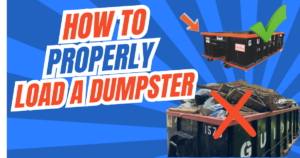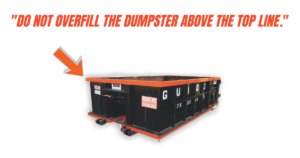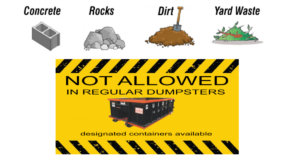 How to Properly Load a Dumpster: A Guide to Avoid Overloading and Ensure Safe Disposal
How to Properly Load a Dumpster: A Guide to Avoid Overloading and Ensure Safe Disposal
When it comes to renting a dumpster for a home renovation, construction project, or major cleanout, one of the most important things to keep in mind is how to load it properly. Overloading a dumpster can lead to a host of problems—from safety hazards and potential fines to added costs and delays in disposal. At Guido’s Services Inc., we strive to help our customers understand the best practices for loading a dumpster to ensure a smooth and efficient waste removal experience. Here’s a comprehensive guide on how to load a dumpster without overloading it.
1. Understand the Weight and Capacity Limits
Every dumpster has a specific weight and volume limit. Before you begin loading, be sure to understand the capacity of the dumpster you have rented. These limits are set to comply with safety regulations and to ensure the dumpster can be safely transported. Overloading a dumpster by weight or volume can result in extra charges or, worse, the inability to haul it away.
Tip: Always ask us or check our dumpsters page about the weight limits for the specific size of the dumpster you are renting. For example, a 10-yard dumpster might have a different weight limit than a 20-yard dumpster. Understanding these limits will help you avoid overloading.
2. Distribute Weight Evenly
One of the most common mistakes people make when loading a dumpster is piling everything up on one side or in the center. Uneven weight distribution can cause the dumpster to tip or become unbalanced during transport, leading to dangerous situations on the road.
Tip: Start by loading heavy items at the bottom and spread them out evenly across the dumpster. As you continue loading, make sure that weight is distributed evenly to avoid any risks associated with an unbalanced load.
3. Break Down Large Items
Large, bulky items can quickly fill up the available space in a dumpster. To maximize space and avoid overloading, break down large items such as furniture, boxes, or construction materials whenever possible. This not only helps in making more room but also allows for a more even weight distribution.
Tip: Use tools like saws or hammers to break down wooden furniture and other bulky items. Stack them flat to create more space for additional waste.
4. Keep the Dumpster Below the Fill Line

Exceeding this line can lead to overloading, making it unsafe for transport. When a dumpster is overloaded, waste may spill out onto the street, creating safety hazards for both the driver and other road users.
Tip: As a general rule, keep the contents of the dumpster below the top edge or fill line. If you’re unsure about the appropriate level, contact your dumpster rental provider for guidance.
5. Avoid Prohibited Items
Certain items are not allowed in dumpsters due to safety and environmental concerns. These include hazardous materials, chemicals, batteries, tires, and appliances that contain Freon. Placing prohibited items in a dumpster can lead to overloading issues and may result in additional fees.
Tip: Ask your dumpster rental provider for a list of prohibited items and make alternative arrangements for their disposal. Local waste management facilities often have designated areas for hazardous waste.
6. Stack Waste Efficiently
To avoid wasting space and risking overloading, stack waste materials efficiently. Place flat items like boards and doors along the sides of the dumpster and layer other debris on top. Bagging loose debris such as leaves or smaller items can also help prevent wasted space.
Tip: Organize your waste in such a way that it takes up the least amount of space. Fill gaps between larger items with smaller ones to maximize the dumpster’s capacity.
7. Do Not Overfill with Heavy Materials

Materials like concrete, dirt, and asphalt are extremely heavy and can easily exceed the weight limits of even the largest dumpsters. If you have a project that involves disposing of heavy materials, consult with your dumpster rental provider to choose a suitable size and weight limit.
Tip: Consider ordering a 20YD long dumpster specifically for heavy materials to avoid overloading and potential fees.
8. Communicate with Your Dumpster Rental Provider
If you are unsure about how to load your dumpster properly or are worried about exceeding weight limits, don’t hesitate to reach out to your rental provider. They can offer advice, suggest alternatives, or even arrange a swap-out service if needed.
Tip: It’s always better to communicate proactively with your dumpster rental company than to face complications later.
9. Plan Ahead and Be Mindful
Proper planning can make a big difference in how efficiently you load your dumpster. Consider the type of materials you’ll be disposing of and how you can optimize the space. Overloading a dumpster not only leads to potential fines but can also delay your project timeline.
Tip: Take a few moments to visualize the loading process before you begin. This simple step can save time, money, and hassle.
Conclusion
Properly loading a dumpster is crucial for safety, efficiency, and cost-effectiveness. By understanding weight limits, distributing weight evenly, and avoiding overfilling, you can ensure a smooth dumpster rental experience. At Guido’s Services Inc., we are here to help guide you every step of the way. Contact us today for any questions or concerns about your dumpster rental and to ensure that your project goes off without a hitch.
Remember: A well-loaded dumpster is not just about fitting everything inside; it’s about doing it safely and responsibly.
